Analyzing Cancer's Impact on Health and Social Care Service Delivery
VerifiedAdded on 2023/04/21
|10
|1005
|354
Report
AI Summary
This report investigates the implications of cancer in communities for the provision of health and social care services. It outlines current approaches and priorities in providing services for individuals with cancer, explaining the relationship between cancer prevalence and the requirements of health and social services. The report details the impact of cancer, including mortality rates and health loss, highlighting lung cancer's connection to lifestyle factors. It discusses various prevention methods, such as primordial, primary, secondary, and tertiary prevention, alongside monitoring and surveillance. The study also examines the bidirectional link between cancer prevalence and healthcare service demands, noting the increased need for services due to rising cancer incidence and decreased life expectancy. It concludes by emphasizing the importance of adapting healthcare strategies to improve service delivery and meet the social and economic needs of individuals affected by cancer. Desklib offers more resources for students.
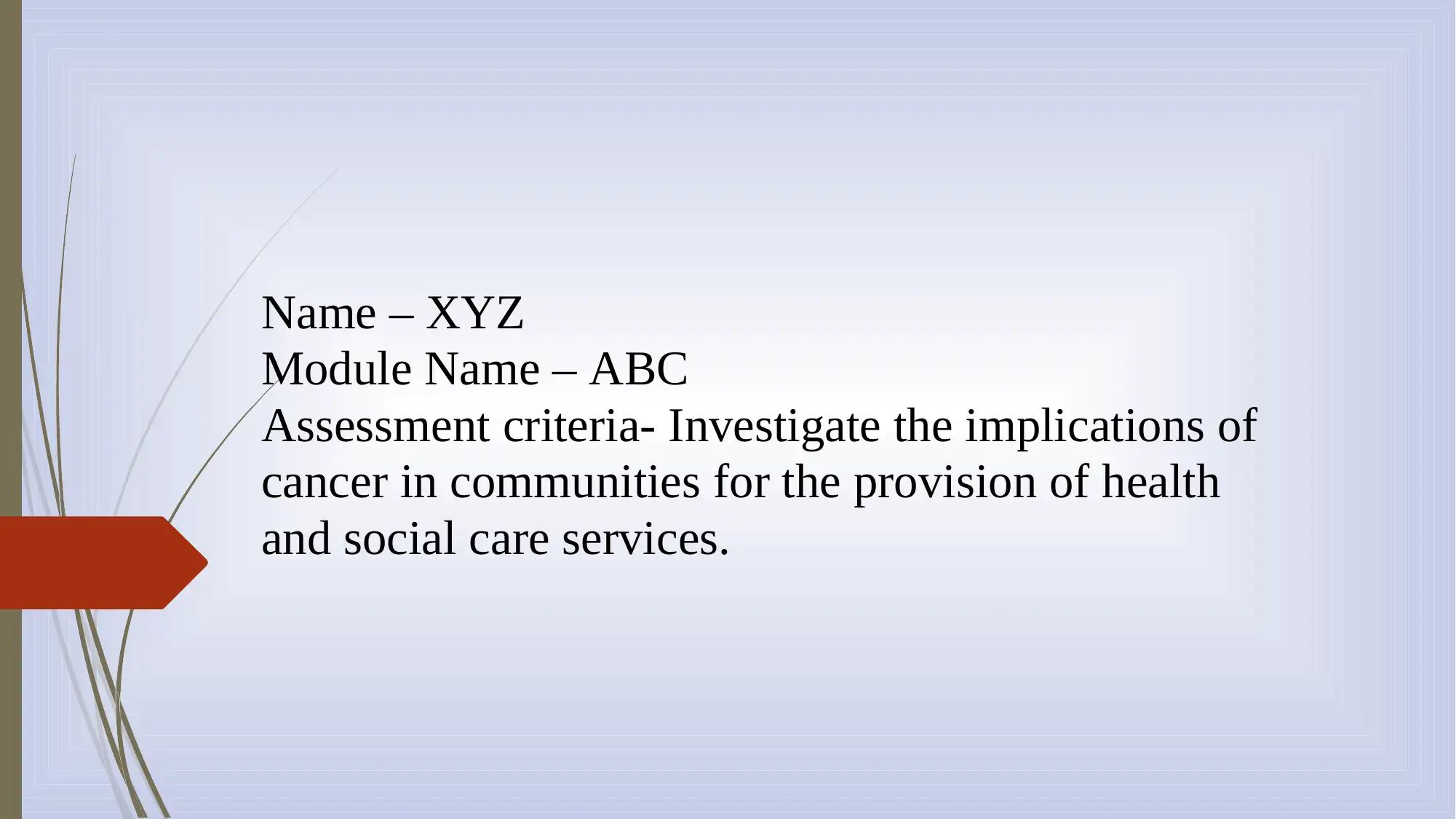
Name – XYZ
Module Name – ABC
Assessment criteria- Investigate the implications of
cancer in communities for the provision of health
and social care services.
Module Name – ABC
Assessment criteria- Investigate the implications of
cancer in communities for the provision of health
and social care services.
Paraphrase This Document
Need a fresh take? Get an instant paraphrase of this document with our AI Paraphraser
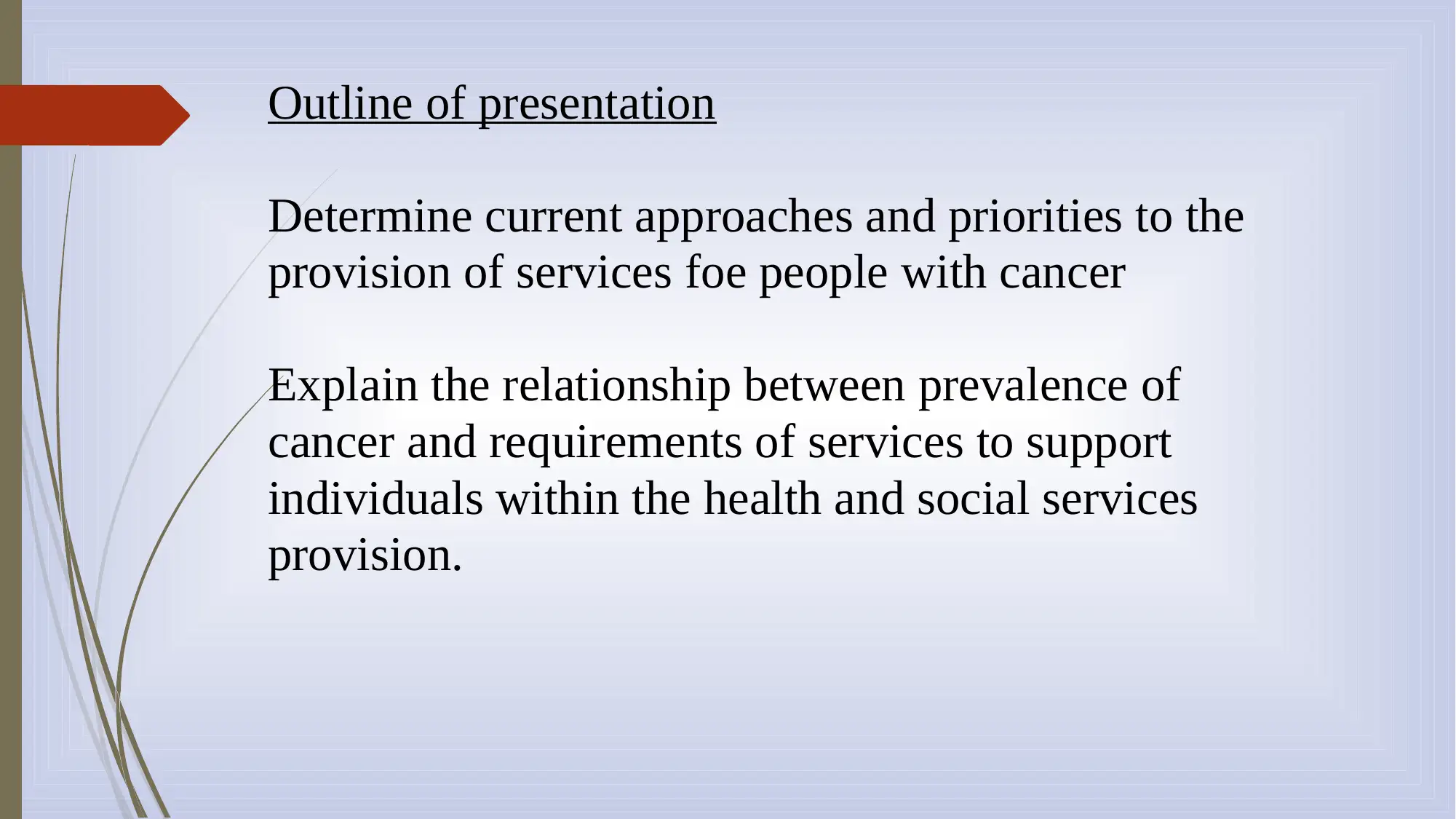
Outline of presentation
Determine current approaches and priorities to the
provision of services foe people with cancer
Explain the relationship between prevalence of
cancer and requirements of services to support
individuals within the health and social services
provision.
Determine current approaches and priorities to the
provision of services foe people with cancer
Explain the relationship between prevalence of
cancer and requirements of services to support
individuals within the health and social services
provision.
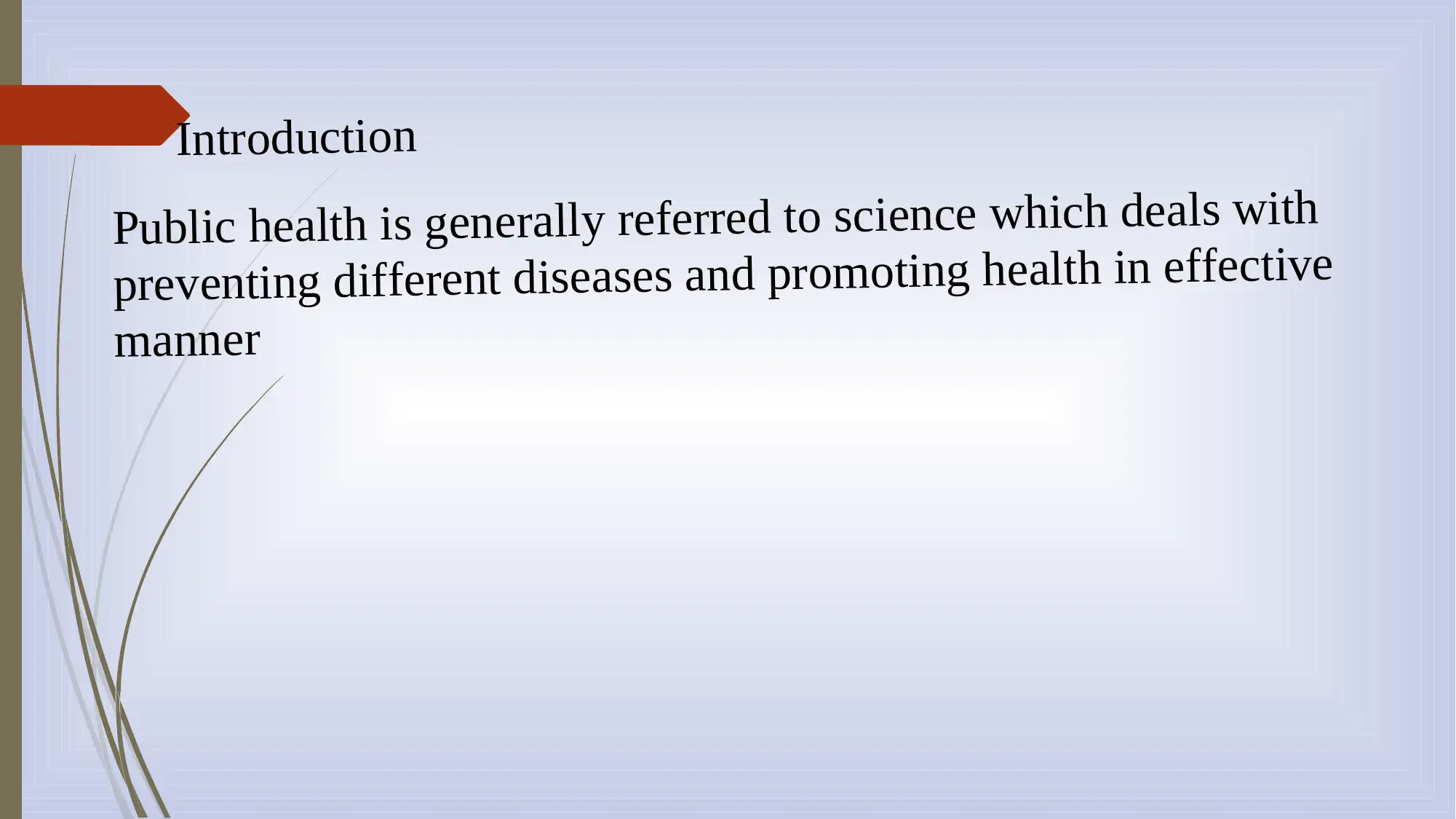
Introduction
Public health is generally referred to science which deals with
preventing different diseases and promoting health in effective
manner
Public health is generally referred to science which deals with
preventing different diseases and promoting health in effective
manner
⊘ This is a preview!⊘
Do you want full access?
Subscribe today to unlock all pages.

Trusted by 1+ million students worldwide
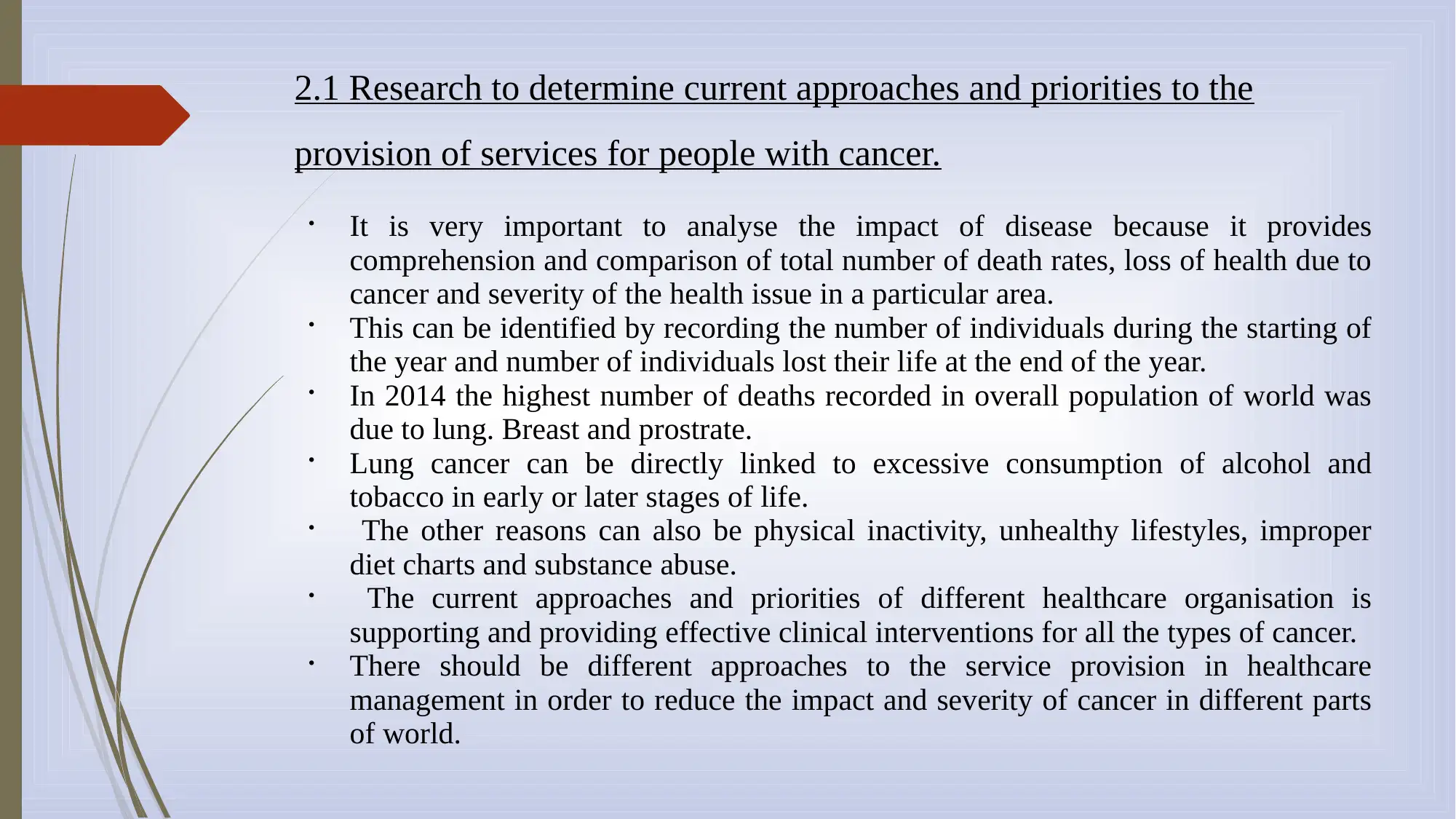
2.1 Research to determine current approaches and priorities to the
provision of services for people with cancer.
It is very important to analyse the impact of disease because it provides
comprehension and comparison of total number of death rates, loss of health due to
cancer and severity of the health issue in a particular area.
This can be identified by recording the number of individuals during the starting of
the year and number of individuals lost their life at the end of the year.
In 2014 the highest number of deaths recorded in overall population of world was
due to lung. Breast and prostrate.
Lung cancer can be directly linked to excessive consumption of alcohol and
tobacco in early or later stages of life.
The other reasons can also be physical inactivity, unhealthy lifestyles, improper
diet charts and substance abuse.
The current approaches and priorities of different healthcare organisation is
supporting and providing effective clinical interventions for all the types of cancer.
There should be different approaches to the service provision in healthcare
management in order to reduce the impact and severity of cancer in different parts
of world.
provision of services for people with cancer.
It is very important to analyse the impact of disease because it provides
comprehension and comparison of total number of death rates, loss of health due to
cancer and severity of the health issue in a particular area.
This can be identified by recording the number of individuals during the starting of
the year and number of individuals lost their life at the end of the year.
In 2014 the highest number of deaths recorded in overall population of world was
due to lung. Breast and prostrate.
Lung cancer can be directly linked to excessive consumption of alcohol and
tobacco in early or later stages of life.
The other reasons can also be physical inactivity, unhealthy lifestyles, improper
diet charts and substance abuse.
The current approaches and priorities of different healthcare organisation is
supporting and providing effective clinical interventions for all the types of cancer.
There should be different approaches to the service provision in healthcare
management in order to reduce the impact and severity of cancer in different parts
of world.
Paraphrase This Document
Need a fresh take? Get an instant paraphrase of this document with our AI Paraphraser
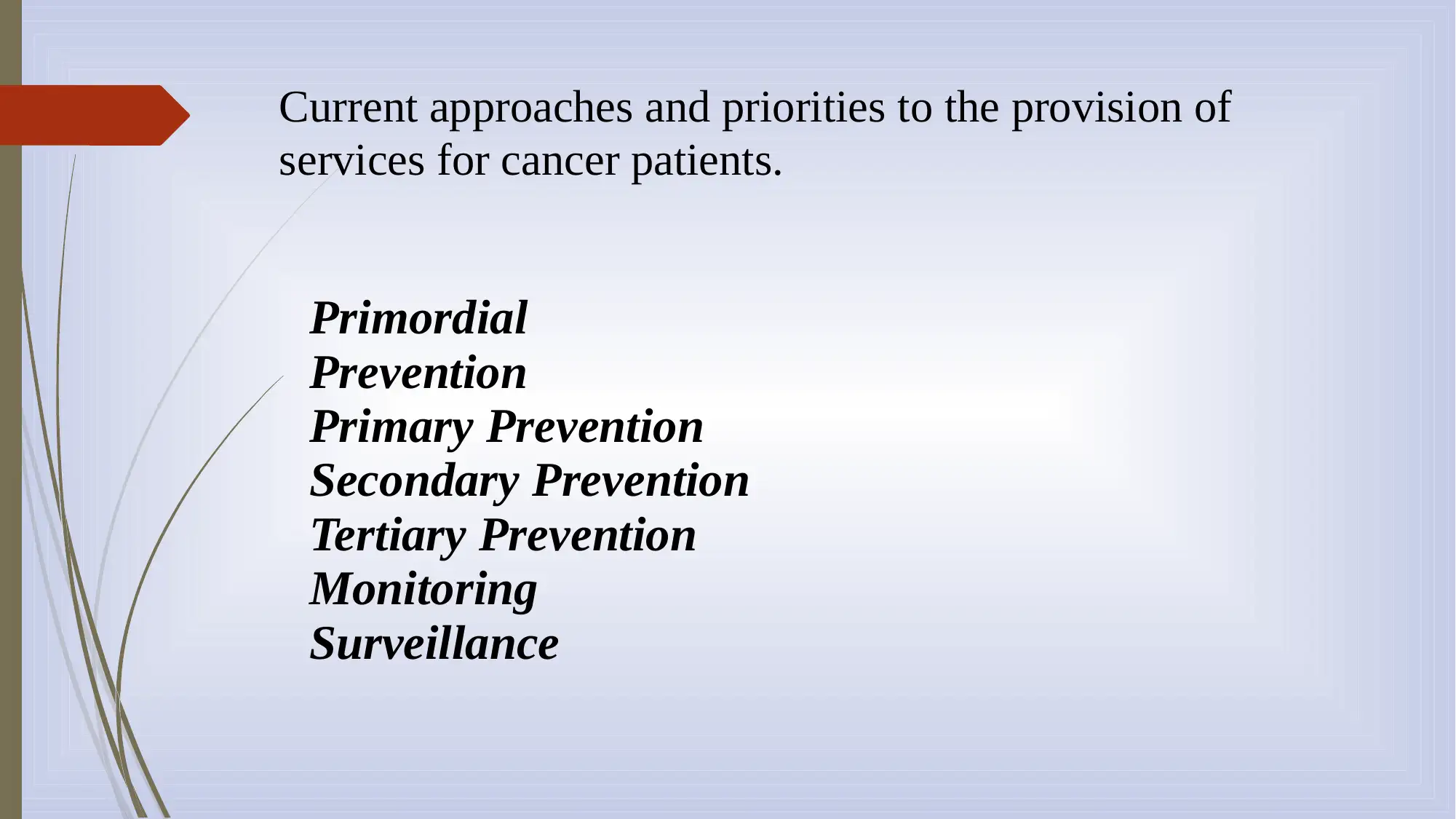
Current approaches and priorities to the provision of
services for cancer patients.
Primordial
Prevention
Primary Prevention
Secondary Prevention
Tertiary Prevention
Monitoring
Surveillance
services for cancer patients.
Primordial
Prevention
Primary Prevention
Secondary Prevention
Tertiary Prevention
Monitoring
Surveillance
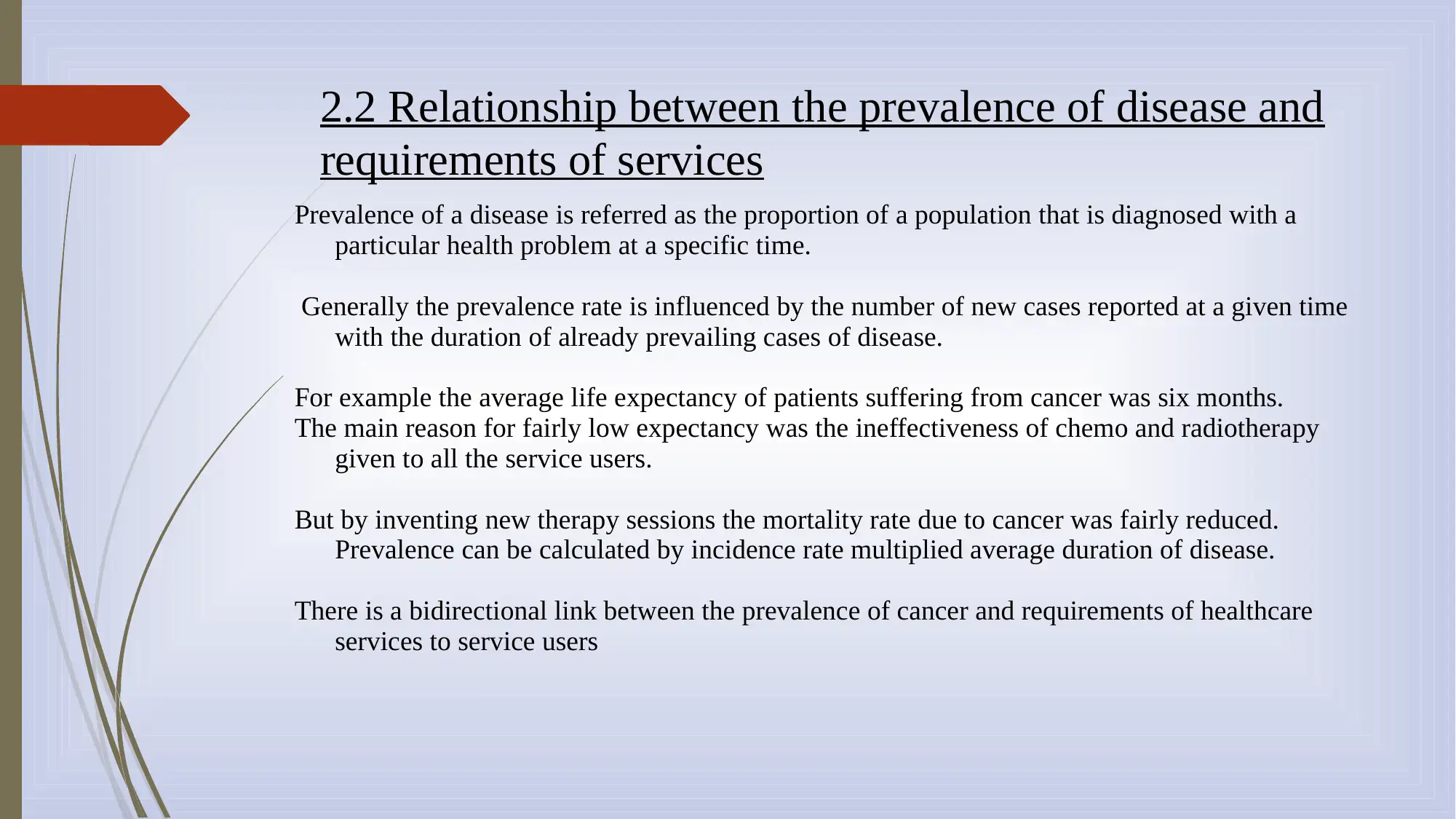
2.2 Relationship between the prevalence of disease and
requirements of services
Prevalence of a disease is referred as the proportion of a population that is diagnosed with a
particular health problem at a specific time.
Generally the prevalence rate is influenced by the number of new cases reported at a given time
with the duration of already prevailing cases of disease.
For example the average life expectancy of patients suffering from cancer was six months.
The main reason for fairly low expectancy was the ineffectiveness of chemo and radiotherapy
given to all the service users.
But by inventing new therapy sessions the mortality rate due to cancer was fairly reduced.
Prevalence can be calculated by incidence rate multiplied average duration of disease.
There is a bidirectional link between the prevalence of cancer and requirements of healthcare
services to service users
requirements of services
Prevalence of a disease is referred as the proportion of a population that is diagnosed with a
particular health problem at a specific time.
Generally the prevalence rate is influenced by the number of new cases reported at a given time
with the duration of already prevailing cases of disease.
For example the average life expectancy of patients suffering from cancer was six months.
The main reason for fairly low expectancy was the ineffectiveness of chemo and radiotherapy
given to all the service users.
But by inventing new therapy sessions the mortality rate due to cancer was fairly reduced.
Prevalence can be calculated by incidence rate multiplied average duration of disease.
There is a bidirectional link between the prevalence of cancer and requirements of healthcare
services to service users
⊘ This is a preview!⊘
Do you want full access?
Subscribe today to unlock all pages.

Trusted by 1+ million students worldwide
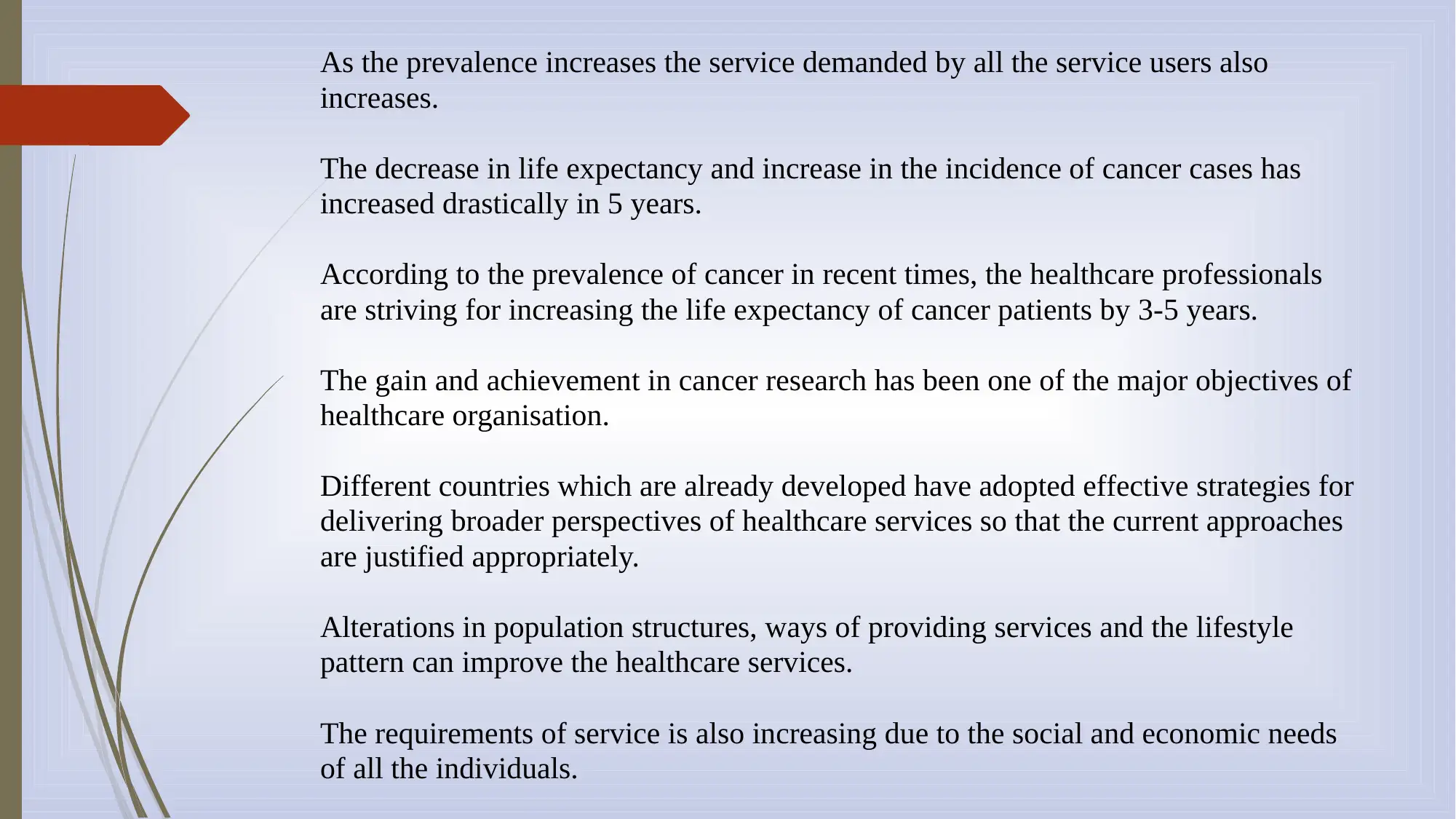
As the prevalence increases the service demanded by all the service users also
increases.
The decrease in life expectancy and increase in the incidence of cancer cases has
increased drastically in 5 years.
According to the prevalence of cancer in recent times, the healthcare professionals
are striving for increasing the life expectancy of cancer patients by 3-5 years.
The gain and achievement in cancer research has been one of the major objectives of
healthcare organisation.
Different countries which are already developed have adopted effective strategies for
delivering broader perspectives of healthcare services so that the current approaches
are justified appropriately.
Alterations in population structures, ways of providing services and the lifestyle
pattern can improve the healthcare services.
The requirements of service is also increasing due to the social and economic needs
of all the individuals.
increases.
The decrease in life expectancy and increase in the incidence of cancer cases has
increased drastically in 5 years.
According to the prevalence of cancer in recent times, the healthcare professionals
are striving for increasing the life expectancy of cancer patients by 3-5 years.
The gain and achievement in cancer research has been one of the major objectives of
healthcare organisation.
Different countries which are already developed have adopted effective strategies for
delivering broader perspectives of healthcare services so that the current approaches
are justified appropriately.
Alterations in population structures, ways of providing services and the lifestyle
pattern can improve the healthcare services.
The requirements of service is also increasing due to the social and economic needs
of all the individuals.
Paraphrase This Document
Need a fresh take? Get an instant paraphrase of this document with our AI Paraphraser
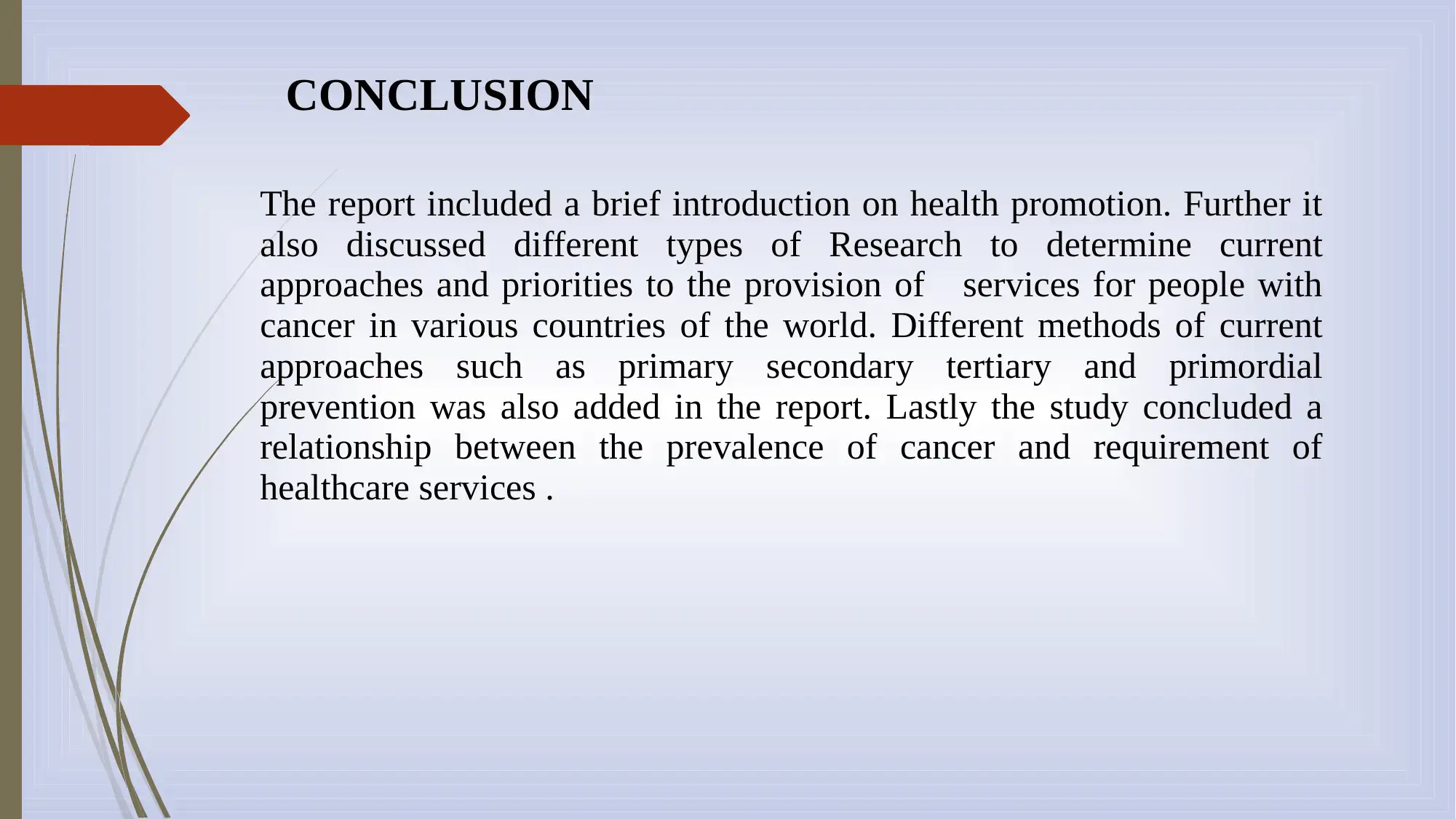
CONCLUSION
The report included a brief introduction on health promotion. Further it
also discussed different types of Research to determine current
approaches and priorities to the provision of services for people with
cancer in various countries of the world. Different methods of current
approaches such as primary secondary tertiary and primordial
prevention was also added in the report. Lastly the study concluded a
relationship between the prevalence of cancer and requirement of
healthcare services .
The report included a brief introduction on health promotion. Further it
also discussed different types of Research to determine current
approaches and priorities to the provision of services for people with
cancer in various countries of the world. Different methods of current
approaches such as primary secondary tertiary and primordial
prevention was also added in the report. Lastly the study concluded a
relationship between the prevalence of cancer and requirement of
healthcare services .
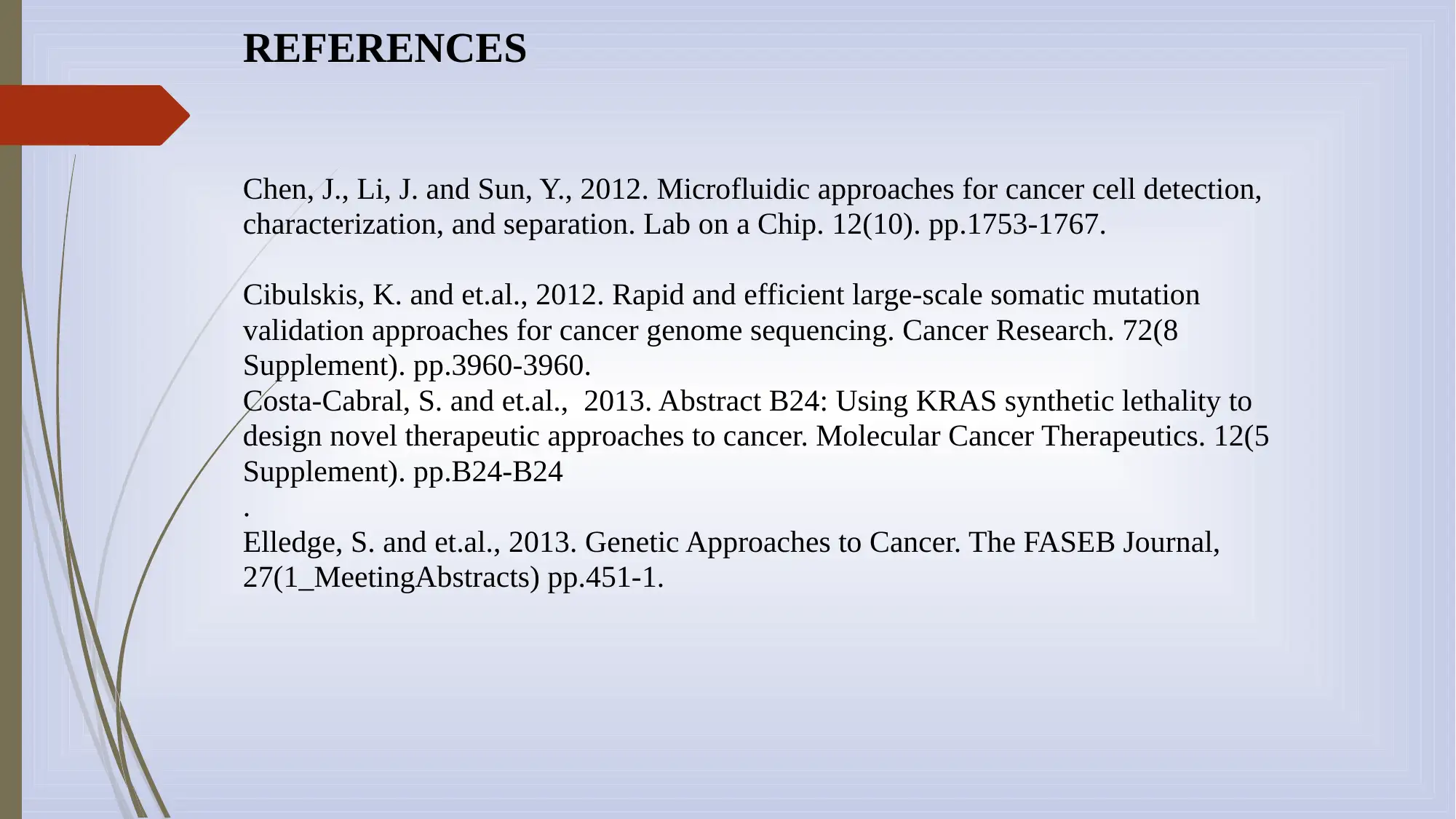
REFERENCES
Chen, J., Li, J. and Sun, Y., 2012. Microfluidic approaches for cancer cell detection,
characterization, and separation. Lab on a Chip. 12(10). pp.1753-1767.
Cibulskis, K. and et.al., 2012. Rapid and efficient large-scale somatic mutation
validation approaches for cancer genome sequencing. Cancer Research. 72(8
Supplement). pp.3960-3960.
Costa-Cabral, S. and et.al., 2013. Abstract B24: Using KRAS synthetic lethality to
design novel therapeutic approaches to cancer. Molecular Cancer Therapeutics. 12(5
Supplement). pp.B24-B24
.
Elledge, S. and et.al., 2013. Genetic Approaches to Cancer. The FASEB Journal,
27(1_MeetingAbstracts) pp.451-1.
Chen, J., Li, J. and Sun, Y., 2012. Microfluidic approaches for cancer cell detection,
characterization, and separation. Lab on a Chip. 12(10). pp.1753-1767.
Cibulskis, K. and et.al., 2012. Rapid and efficient large-scale somatic mutation
validation approaches for cancer genome sequencing. Cancer Research. 72(8
Supplement). pp.3960-3960.
Costa-Cabral, S. and et.al., 2013. Abstract B24: Using KRAS synthetic lethality to
design novel therapeutic approaches to cancer. Molecular Cancer Therapeutics. 12(5
Supplement). pp.B24-B24
.
Elledge, S. and et.al., 2013. Genetic Approaches to Cancer. The FASEB Journal,
27(1_MeetingAbstracts) pp.451-1.
⊘ This is a preview!⊘
Do you want full access?
Subscribe today to unlock all pages.

Trusted by 1+ million students worldwide
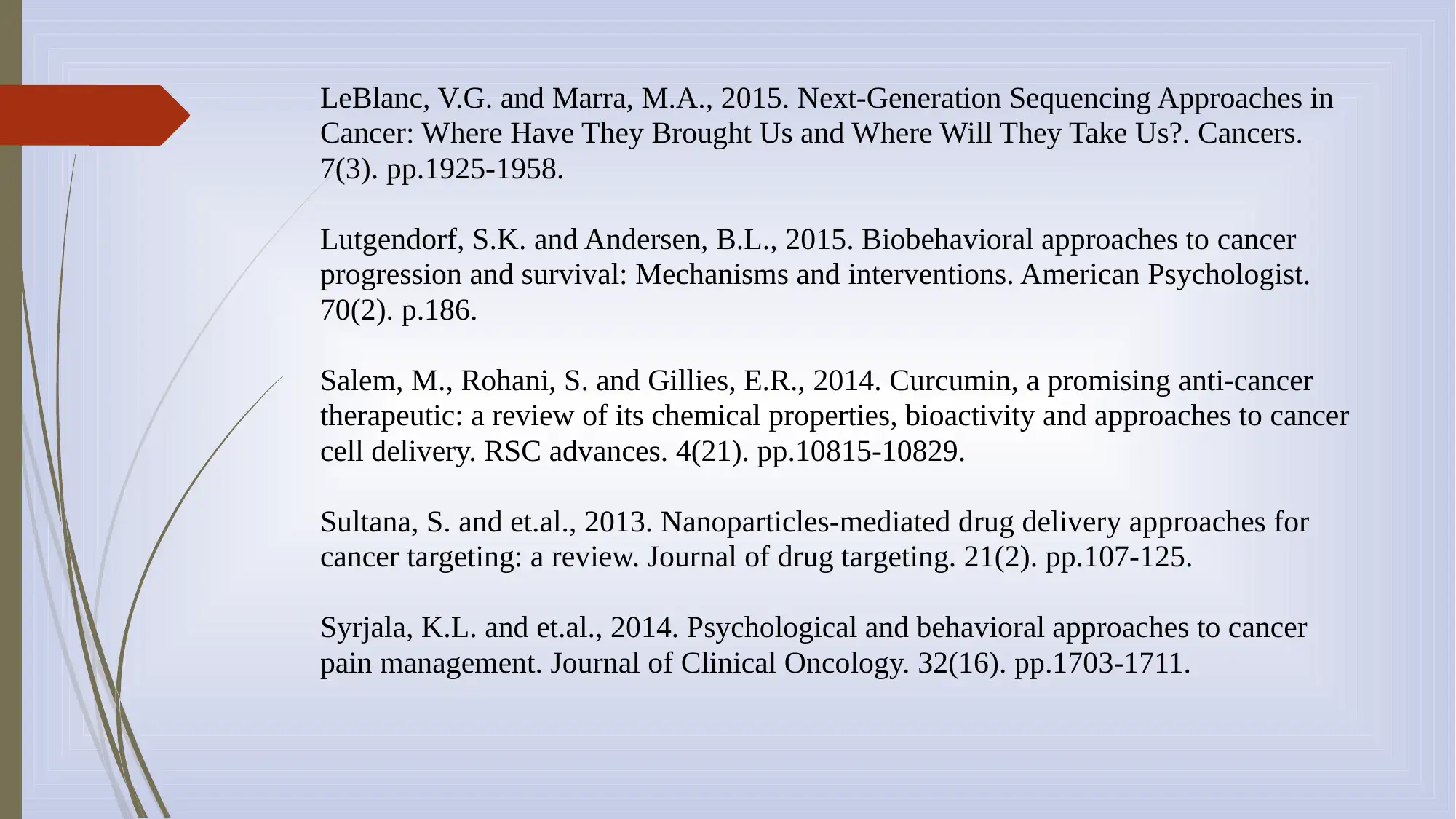
LeBlanc, V.G. and Marra, M.A., 2015. Next-Generation Sequencing Approaches in
Cancer: Where Have They Brought Us and Where Will They Take Us?. Cancers.
7(3). pp.1925-1958.
Lutgendorf, S.K. and Andersen, B.L., 2015. Biobehavioral approaches to cancer
progression and survival: Mechanisms and interventions. American Psychologist.
70(2). p.186.
Salem, M., Rohani, S. and Gillies, E.R., 2014. Curcumin, a promising anti-cancer
therapeutic: a review of its chemical properties, bioactivity and approaches to cancer
cell delivery. RSC advances. 4(21). pp.10815-10829.
Sultana, S. and et.al., 2013. Nanoparticles-mediated drug delivery approaches for
cancer targeting: a review. Journal of drug targeting. 21(2). pp.107-125.
Syrjala, K.L. and et.al., 2014. Psychological and behavioral approaches to cancer
pain management. Journal of Clinical Oncology. 32(16). pp.1703-1711.
Cancer: Where Have They Brought Us and Where Will They Take Us?. Cancers.
7(3). pp.1925-1958.
Lutgendorf, S.K. and Andersen, B.L., 2015. Biobehavioral approaches to cancer
progression and survival: Mechanisms and interventions. American Psychologist.
70(2). p.186.
Salem, M., Rohani, S. and Gillies, E.R., 2014. Curcumin, a promising anti-cancer
therapeutic: a review of its chemical properties, bioactivity and approaches to cancer
cell delivery. RSC advances. 4(21). pp.10815-10829.
Sultana, S. and et.al., 2013. Nanoparticles-mediated drug delivery approaches for
cancer targeting: a review. Journal of drug targeting. 21(2). pp.107-125.
Syrjala, K.L. and et.al., 2014. Psychological and behavioral approaches to cancer
pain management. Journal of Clinical Oncology. 32(16). pp.1703-1711.
1 out of 10
Related Documents
Your All-in-One AI-Powered Toolkit for Academic Success.
+13062052269
info@desklib.com
Available 24*7 on WhatsApp / Email
![[object Object]](/_next/static/media/star-bottom.7253800d.svg)
Unlock your academic potential
Copyright © 2020–2025 A2Z Services. All Rights Reserved. Developed and managed by ZUCOL.





